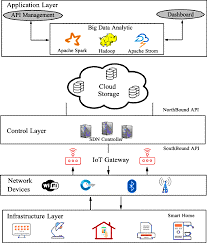A New Cloud with IoT-Enabled Innovation and Skill Requirement of College English Teachers on Blended Teaching Model
Main Article Content
Abstract
The blended teaching model is a type of educational approach that combines traditional classroom-based instruction with online learning experiences. In this model, students are given access to digital content, resources, and tools, which they can use to supplement their in-person classroom instruction. The blended teaching model is also sometimes referred to as the hybrid learning model. IoT-SDNCT (IoT enabled SDN reinforcement learning with Cloud Technological Innovation and Skill Requirement of College English Teachers on Blended Teaching Model) is a proposed system that aims to revolutionize blended teaching models by leveraging the power of IoT, SDN, and cloud computing technologies. This system incorporates intelligent reinforcement learning algorithms and real-time data analysis to optimize the learning process and improve student engagement and outcomes. In the IoT-SDNCT system, IoT devices such as sensors and wearable technologies are deployed to collect real-time data on student engagement and performance. This data is then transmitted to an SDN controller, which dynamically manages the network infrastructure and optimizes learning pathways. The collected data is also stored and processed in cloud computing platforms, allowing for advanced analytics and personalized feedback for both students and teachers. The key contribution of IoT-SDNCT lies in its ability to adapt the learning process in real-time based on the collected data and intelligent algorithms. This adaptive learning approach enables personalized learning experiences, adjusts the difficulty level of learning tasks, and provides timely feedback to students. Moreover, it empowers teachers with valuable insights and analytics to enhance their teaching strategies and address individual student needs effectively. The proposed system addresses the technological innovation and skill requirements of college English teachers by integrating IoT, SDN, and cloud computing technologies. By utilizing IoT devices, SDN controllers, and cloud platforms, teachers can optimize their teaching methods and create dynamic and interactive learning environments. This not only enhances student engagement but also improves learning outcomes and fosters skill development in both teachers and students. The system's adaptive learning capabilities and real-time data analysis contribute to an enhanced learning experience, increased student engagement, and improved teaching effectiveness.
Article Details
References
Wang, Y. (2020). A study on college English high-efficiency class based on blended teaching mode of flipped classroom. Theory and Practice in Language Studies, 10(9), 1066-1071.
Moradimokhles, H., & Hwang, G. J. (2022). The effect of online vs. blended learning in developing English language skills by nursing student: An experimental study. Interactive Learning Environments, 30(9), 1653-1662.
Xiao-Dong, L., & Hong-Hui, C. (2020). Research on VR-supported flipped classroom based on blended learning—a case study in “learning english through news.”. International Journal of Information and Education Technology, 10(2), 104-109.
Tupas, F. P., & Linas-Laguda, M. (2020). Blended Learning–An Approach in Philippine Basic Education Curriculum in New Normal: A Review of. Universal Journal of Educational Research, 8(11), 5505-5512.
Zou, C., Li, P., & Jin, L. (2021). Online college English education in Wuhan against the COVID-19 pandemic: Student and teacher readiness, challenges and implications. PloS one, 16(10), e0258137.
Utamajaya, J. N., Manullang, S. O., Mursidi, A., Noviandari, H., & BK, M. K. U. (2020). Investigating The Teaching Models, Strategies And Technological Innovations For Classroom Learning After School Reopening. PalArch's Journal of Archaeology of Egypt/Egyptology, 17(7), 13141-13150.
Gulnaz, F., Althomali, A. D. A., & Alzeer, D. H. (2020). An investigation of the perceptions and experiences of the EFL teachers and learners about the effectiveness of blended learning at Taif University. International Journal of English Linguistics, 10(1), 329-344.
Wang, X., & Zhang, W. (2022). Improvement of students’ autonomous learning behavior by optimizing foreign language blended learning mode. Sage Open, 12(1), 21582440211071108.
Rahman, A. M. A., Azmi, M. N. L., & Hassan, I. (2020). Improvement of English writing skills through blended learning among university students in Malaysia. Universal Journal of Educational Research, 8(12A), 7694-7701.
Quvanch, Z., & Na, K. S. (2020). A review on impact of blended learning on the English writing skills. Innovative Teaching and Learning Journal (ITLJ), 4(1), 41-50.
Warman, L. A. D. (2021). The effect of Google classroom in Blended Learning on university students’ English ability. J-SHMIC: Journal of English for Academic, 8(1), 12-23.
Mulyadi, D., Arifani, Y., Wijayantingsih, T. D., & Budiastuti, R. E. (2020). Blended learning in English for specific purposes (ESP) instruction: Lecturers’ perspectives. Computer-Assisted Language Learning Electronic Journal, 21(2), 204-219.
Huang, Y., & Huang, Y. (2022). The Impact of Blended Learning on Student Motivation in College English Classes. Journal of Language Teaching and Research, 13(1), 89-98.
Liu, H., & Liu, Q. (2021). Implementation of blended teaching in college English courses: Benefits and challenges. International Journal of Emerging Technologies in Learning, 16(3), 63-72.
Shen, Z., & Chen, X. (2021). Challenges of blended teaching in college English classes and strategies for improvement. Journal of Language Teaching and Research, 12(3), 539-548.
Wang, C., & Sun, J. (2022). Exploring the effects of gamification on college English teaching under the blended teaching model. International Journal of Emerging Technologies in Learning, 17(2), 65-78.
Wang, Y., & Hu, X. (2021). The impact of flipped learning on college English teaching under the blended teaching model. International Journal of Emerging Technologies in Learning, 16(3), 118-131.
Wang, Y., & Chen, Y. (2020). The development of digital literacy skills in college English teachers under the blended teaching model. Computer-Assisted Language Learning, 33(1-2), 85-106.
Wu, H., & Xie, F. (2021). An empirical study of the application of blended teaching model in college English teaching. International Journal of Emerging Technologies in Learning, 16(3), 73-87.
Yang, Y., & Zhang, W. (2022). Exploring the effectiveness of the blended teaching model in college English writing teaching. Journal of Language and Linguistics Studies, 18(2), 36-52.
Zhang, Y., & Feng, L. (2020). Research on the design of college English blended teaching model based on MOOC. Open Education Research, 26(2), 36-43.

